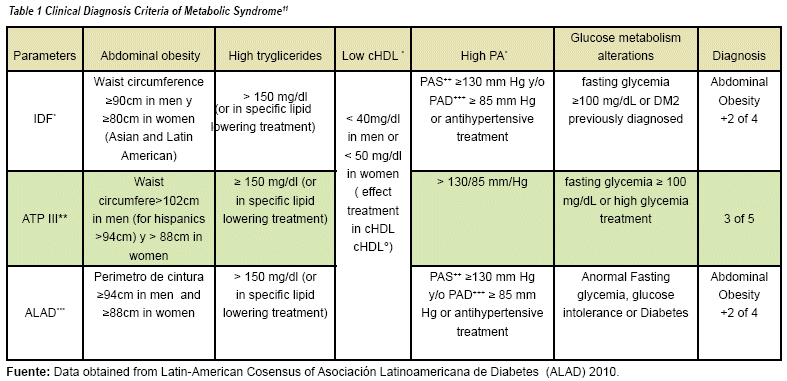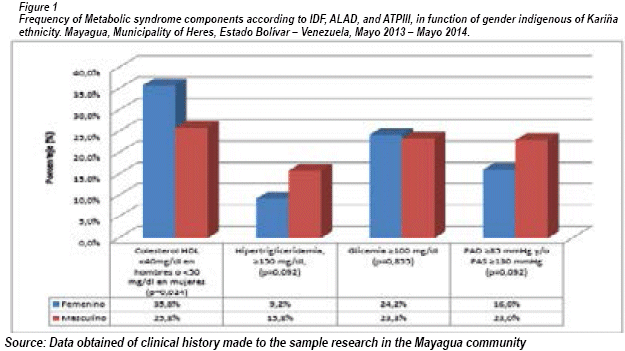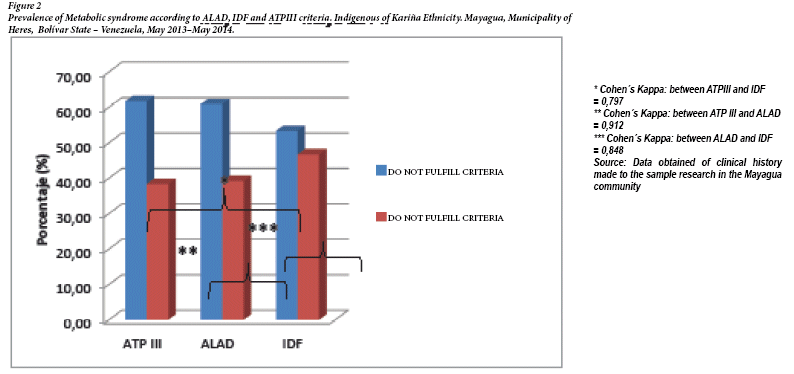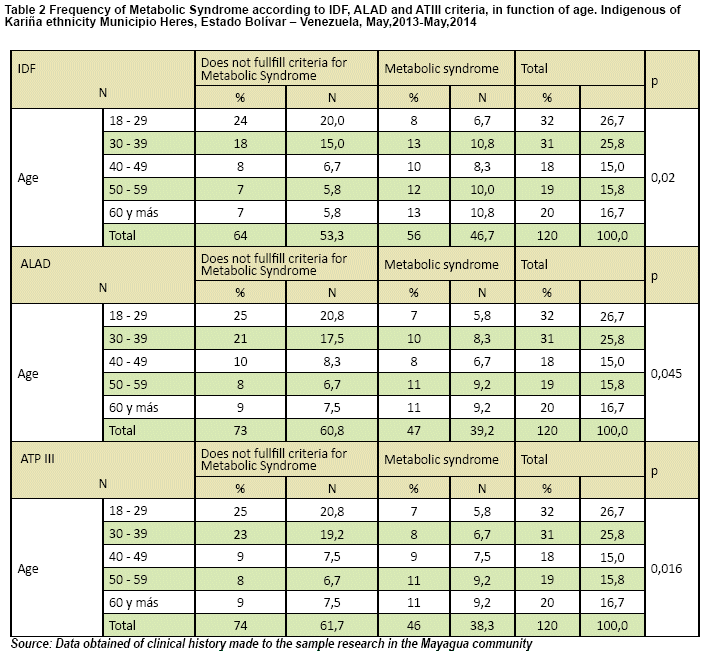Serviços Personalizados
Journal
Artigo
Indicadores
-
 Citado por SciELO
Citado por SciELO -
 Acessos
Acessos
Links relacionados
-
 Similares em
SciELO
Similares em
SciELO
Compartilhar
Revista Científica Ciencia Médica
versão impressa ISSN 2077-3323
Rev Cient Cienc Méd vol.21 no.1 Cochabamba 2018
Original article
PREVALENCE OF METABOLIC SYNDROME AND RISK FACTORS KARIÑA ETHNICITY, BOLIVAR STATE, VENEZUELA
Deymar Quiroz1, Deynalia Quiroz1, Francisco J. Bognanno2, Melania Marin2
1 Medical Surgeon, Health Science
School Dr. “Francisco Battistini
Casalta”, University of Oriente,
Núcleo Bolívar,
2 Internal Physician, Department
of Internal Medicine, University
Hospital Ruiz y Páez, Bolívar City,
Bolívar State, Venezuela.
Correspondence to: DeymarQuiroz deymardla053@gmail.com Telf. y celular: 0593991608447/0593993722775
Received for publication: December, 14 2016
Accepted for publication: July, 14 2018
Cite as: Rev Cient Cienc Med 2018;20(1):7-20
Abreviatures used in this scientific paper:
*IDF: International Diabetes Federation
**ATP III: Adults Treatment Panel III
***ALAD: Associacion Latin American Diabetes
+BP: Blood Pressure
++PAS: Blood Pressure Systolic
+++PAD: Blood Pressure Dyastolic
°cHDL: cholesterol high density lypoproteins
°°DM2: Diabetes Mellitus type 2
ABSTRACT
Metabolic Syndrome includes the association of risk factors: hypertension, obesity, dyslipidemia and insulin resistance, which increases the possibility of developing cerebrovascular, cardiovascular and diabetes diseases. General objective: To determine the prevalence of the Metabolic Syndrome and its risk factors in individuals of the Kariña ethnic group. May 2013 - May 2014.
Methods: An observational, descriptive study and cross section study was conducted; with a universe of 203 individuals, and a sample of 120 individuals (18-85 years) of the Kariña ethnic group of the Community of Mayagua, Bolívar State, Venezuela.
In all participants, the lipid profile was analyzed with the colorimetric method. The glycemia was quantified with a glucometer prior to fasting for 12 hours.The diagnostic criteria of the International Diabetes Federation, the Latin American Diabetes Association and the Adult Treatment Panel III were used.
Results: the prevalence of the metabolic syndrome was 46,67% according to the International Diabetes Federation, 39,17% Latin American Diabetes Association, and 38.33% Adult Treatment Panel II, the Kappa (k) concordance between AdultTreatment Panel III and International Diabetes Federation indicates a considerable concordance force, said Index between Adult Treatment Panel III and LatinAmerican Diabetes Association denotes an almost perfect match strength as does the index between Latin American Diabetes Association and International Diabetes Federation. Conclusion: A high prevalence of metabolic syndrome was found by both the LatinAmerican Diabetes Association, International Diabetes Federation and Adult Treatment Panel III criteria, with predominance in the female gender and individuals over 50 years old.
Keywords: obesity, hyperglycemia and dyslipidemia.
INTRODUCTION
Metabolic Syndrome associates a group of risk factors: arterial hypertension, obesity, dyslipidemia and Insulin Resistance (related to increased body fat and lack of physical activity), which increase the probability of developing cerebrovascular and cardiovascular diseases, and diabetes1-3.
In 1998, The World Health Organization (WHO) describes this syndrome by the presence of Diabetes type 2, alterations of glucose tolerance, insulin resistance, or fasting hyperglycemia, coinciding with at least two of the following criteria such as blood pressure ≥140/90mmHg; triglycerides ≥150mg/dl or High Density Lipoprotein-cholesterol (HDL) <35mg/dl for men and <39mg/dl for women; waist-hip ratio >0,90 for men and >0,85 for women; Body Mass Index (BMI) >30kg/m2; microalbuminuria ≥20μg/min or albumin-creatinine ratio ≥30mg/g4,5. The Asociación Latinoamericana de Diabetes (ALAD) established that abdominal girth >94 cm for men and >88 cm for women, makes Metabolic Syndrome diagnosis.
In addition, life style, ethnicity and urbanization influenced in the high incidence of this syndrome. In Latin America, it's expected to rich 14% in the next 10 years8. In Zulia-Venezuela State, one study determined that one-fourth of above 20 year-old population have obesity, and one-third Metabolic syndrome9. Health, Education and production conventional system have been modified by oilfield exploitation and urbanization10. Due to indigenous groups, health has changed over time, which has been associated to lifestyle changes given their proximity to large cities, moreover exist few researchers that document about this syndrome in Venezuelan indigenous ethnic groups; The principal motivation to do research about this topic was to determine the prevalence of Metabolic syndrome in this group of people.
MATERIALS AND METHODS
It was performed a cross-transversal and descriptive study in Mayagua community, Orinoco Parish church, Heres borough, Bolívar-Venezuela State. The universe is formed by 203 Kariñas between 18-85 years old with direct ancestry, from which was decided to sample 120 (59,1% of Kariña population)individuals using the following formula:
![]()
Where: n=sample size; N=population size; σ=Population Standard Deviation, it was used a constant value of 0,5; Z=-confidence levels, it was employed 95% of confidence that is equal to 1,96;e=Margin of error with a value of 6% (0,06).
The inclusion criteria involves: Kariña ethnic group individuals, male and female sex of direct ancestry between 18-85 years old. The exclusion criteria includes, indigenous from a different ethnic group ancestry, pregnant women, diagnosis of endocrine-metabolic diseases, Metabolic syndrome, Diabetes Mellitus and Cushing's syndrome.
The materials used were: an aneroid sphygmomanometer (Lane Aneroide CEO123), stethoscope, (Littmann Brand Classic II S.E.), tape measure (1,50cm), sterile gloves, cotton, syringe of 5cc, scalpel n°21, tubes with red end caps, Blood-Glucose Monitoring System (SUMASENSOR SXT CE0123), Blood-Glucose Biosensor (SUMASENSOR SXT) and sterile lancets for single use only (LIANFA 28G).
To the recollection data was necessary an informed consent form, in which identification data, genre, ethnicity, waist circumference, systolic blood pressure (SBP) and diastolic blood pressure (DBP) were registered.
The lipid profile which includes total cholesterol, high density lipoprotein (HDL), low density lipoprotein (LDL), very low density lipoprotein (VLDL) and tryglicerids were obtained through a blood sample analyzed with the colorimetric method. Blood sugar levels were quantified with a glucometer, a 12-hour fast was required. The criteria of ATP III, IDF and ALAD (see Table 1) were applied to determine the prevalence of Metabolic syndrome11.
The Statistical analysis was made by SPSS® 23 program (versión 23; Statistical Packageforthe Social Sciences, SPSS Inc, Chicago, IL). Tables and figures were made in Microsoft Excel® 2010 program. Data were analyzed throughout descriptive statistics as the mean, standard deviation, minimum and maximum value, absolute and relative frecuencies.
The normality of variables were assessed by the Kolmogorov-Smirnov test. Due to, evaluated variables did not follow the normal distribution, were assessed with the Chi-squared test. The confidence interval was 95% and the differences are statistically significant with a p<0,05. To assess the concordance between ALAD, International Diabetes Federation (IDF), Adult Treatment Panel III (ATP III) criteria, the Cohen's kappa coefficient was applied and a scale that express the force of concordance qualitatively was used to interpret it.
According to Landis and Koch, it is considered: no agreement, a Kappa coefficient (k) of 0,00; slight, a Kappa coefficient (k) between 0,01-0,2; fair 0,21-0,40; moderate 0,41-0,60; 0,61-0,80 as substantial; 0,81-1,0 as almost perfect agreement12.
RESULTS
It was obtained the average age 42,07±16,81 years old, waist circumference 93,88±14,96 cm, HDL 43,05±9,66 mg/dl, triglycerides 130,98±116,55 mg/dl, fast blood sugar 102,45±19,03 mg/dl, SBP 120,75±14,68 mmHg y DBP 81,17±13,36mmHg.
According to IDF, the abdominal obesity frecuency is 77% (n=92), (male sex 39%[n=47] y female 38%[n=45]), ALAD indicates 58%(n=70) (female sex 31%[n=37] y male 28%[n=33]), ATP III mentions 47%(n=56) (female sex 31%[n=37] y male 16%[n=19]); There was not significant difference between IDF and ALAD in gender, while ATP III presents significant differences.
As stated by IDF, abdominal obesity was predominant in the 30-39 years old group with 21,7%(n=26) and ATPIII with 11,7%(n=14); without significant differences at a rate of p=0,106 y p=0,068 respectively. In respect of ALAD ruled over the age group with a 15,8%(n=19) and a significant difference of (p=0,025).
Low levels of HDL in female was 35,8%(n=43) and 25,8%(n=31) in male, which make a significant difference. Hypertriglyceridemia was higher in men with 15,8%,(n=19) compared to women with 9,2%[n=11]; Fast blood glucose ≥100 mg/dL more in women 24,2%(n=29) than men 23,3%(n=28), blood pressure (DBP ≥85 mmHg y/o SBP ≥ 130 mmHg), 23%(n=28) in men and 16%(n=19) in women. There weren't significant differences about gender for this criteria (Figure 1).
The 61,6% (n=74) of population presented low levels of HDL, it's predominant with 16,7%(n=20) in 18-29 years old age group, without significant difference (p=0,653); high triglycerides prevail in 30-39 (7,5%[n=9]) and 40-49 years old (7,5%[n=9]) with significant differences (p=0,018). Fast blood glucoses 100 mg/dL is predominant 47,5%(n=57), 18-29 years old group was the most affected with 10,8%(n=13) no significant difference (p=0,115). The 39,1%(n=47) show DBP≥85 mmHg and SBP≥130 mmHg, 50-59 years group are disproportionately affected with 12,5%(n=15) and significant difference (p=0,000).
The prevalence of metabolic syndrome was major according to IDF 46,67%(n=56), followed by ALAD 39,17%(n=47), and finally ATPIII 38,33%(n=46). In the one hand, the Kappa (k) concordance between ATP III and IDF was 0,797, which indicates a significant force of concordance; On the other hand, the Kappa (k) concordance between ATP III and ALAD was 0,912 showed an almost prefect agreement; Last, the Kappa (k) concordance between ALAD and IDF was 0,848 almost prefect agreement too (Figure 2).
In terms of prevalence of metabolic syndrome, female gender is disproportionately affected based on ALAD information 20,83%(n=25), ATPIII 20,83%(n=25), while based on IDF both female and male gender are predominant 23,33%(n=28), no significantly statistics differences were found.
According to the age group we found significant differences, 50-59 years (9,2%[n=11]) are the most affected among 60 years onwards (9,2%[n=11]), reported by ALAD (p=0,045) and ATP III (p=0,016), IDF (p=0,02) is predominant in 30-39 years (10,8%[n=13]), 60 years onwards (10,8%[n=13]) for each group (Table 2).
DISCUSSION
Age, various population ethnicity, lifestyle, environment, and nutritional status between countries, may have effects in prevalence of metabolic syndrome13,14. In respect to waist circumference average value was 93,88±14,96 cm, higher than Waraos indigenous ethnicity (91,02±11,50 cm) mentioned by Brito et al 20138 and Añu indigenous Age, various population ethnicity, lifestyle, environment, and nutritional status between countries, may have effects in prevalence of metabolic syndrome13,14. In respect to waist circumference average value was 93,88±14,96 cm, higher than Waraos indigenous ethnicity (91,02±11,50 cm) mentioned by Brito et al 20138 and Añu indigenous (89,74±15,43 cm) by Bermúdez et al 200915, considered a criterion of abdominal obesity according to IDF, ATP III y ALAD11. The relative high visceral adipose tissue amount compared with subcutaneous cellular tissue, plus high abdominal circumference in Asian and Hindu people, may explain a greater prevalence of this syndrome unlike African-American men who tend to subcutaneous fat16.
According to HDL concentration, it was obtained an arithmetic mean of 43,05±9,66 mg/dl, compared to Brito et al 20138 (41 ±12,21 mg/dl) y Bermúdez et al 200915 (39,1 ±10,6 mg/dl) in which results were higher, low levels of HDL represented a diagnostic criterion used for metabolic syndrome. In the one hand, triglycerides had an arithmetic average of 130,98±116,55 mg/dl, less than Brito et al 2013 study (135,05±65,70 mg/dl)8; on the other hand, fast blood glucose was 102,45±19,03 mg/dl, also representing a diagnostic criterion to metabolic syndrome11, but was higher in Brito et al 2013 study8 (82,89±26,24 mg/dL).
There is a mean for SBP 120,75±14,68 mmHg and DBP 81,17±13,36 mmHg, similar to the reported by Brito et al 2013 (SBP 123,28±15,27 mmHg; DBP 78,11 ±9,67 mmHg)8.
Abdominal obesity is more frequent in female gender 31% than male 28% according to ALAD. ATP III show female 31% and male 16% similar to Brito et al8 (ALAD: female 55,9% and male 51,9%; ATPIII female 61,8 %and male 22,2%, in contrast IDF shows male gender as the more affected 39% compared to female 38%, which differ from Brito et al8 female 91,2% and male 55,6%. The Strong Heart study stablished indigenous community Pima presents higher riskof becoming obese due to 50% of adult population is obese17. In Chile, previous studies described a gradual increase prevalence of Mapuche ethnicity individuals in urban area different from rural area, it may result from an adaptation process of behaviors from their way of life to modern habits13. In the Cardiovascular Risk Factor Multiple Evaluation Latin America (CARMELA) scientific study, in 2008, was reported an obesity abdominal prevalence increased with age, finding similar to this study18.
Obesity could be one of the principal reasons of high metabolic syndrome prevalence due to, it increases with the rise in obesity, smultaneously14. Visceral or abdominal adipose tissue is active by lypolisis, tumor necrosis factor α (TNF-α), leptin, resistin, inteleukin-6 (IL-6) and other substances that can develop proinflammatory state, endothelial damage or insulin resistance, because it produces an insulin sensitivity change of muscle tissue because of higher free fatty acids that cause metabolism glucose inhibition, moreover an increased lipogenesis, gluconeogenesis, VLDL, LDLand lower HDL19,20. The release of free fatty acids is due to the action of catecholamines on β3 receptor, have lypolitic activity in visceral adipose tissue21.
Furthermore, the release of TNF-α is able to maintain a high concentration of free fatty acids, due to stimulates fat breakdown (lipolysis) and suppress lipogenesis resulting in impaired insulin sensitivity22.
In the hyperglycemia was found a frequency of 47,50% higher than Bermudez et al 2009 (14%)15 and Brito et al 2013 (9,8%)8. Some indigenous population studies of Mexico reported a prevalence of diabetes mellitus 4,4% in Otomies indigenous of Querétaro; in tribes including Pima of Sonora, male 6,3% y female 10,5%; Mazatecas of Oaxaca 2,1%, and other types of metabolic disorders in tepehuana, huichol y mexicanera de Durango; mayas de Yucatán and triquis de Oaxaca23,24.
Prevalence of Metabolic syndrome in Kariña indigenous group is higher than Waraos8 and Añú15, more frequent in female gender in Añu15 and Waraos8 areas, CARMELA study18 and a systematic review performed by De Carvalho et al in Brazilian adults, an indigenous group of Río Grande do Sul, it was determined metabolic syndrome prevalence 65,3% used NCEP-ATP III (2001)25 as a diagnostic criteria. Gyakobo et al performed in Ghana, a rural population study, in which metabolic syndrome was more frequent in women, taking into account IDF y NCEP ATP III criteria for diagnosis, is in line with this research paper26. According to Misra, et al metabolic syndrome prevalence in Sri Lanka is higher, corresponding to men 35% and 51% are women, what this again highlights an increased frequency in women27. In China, the prevalence is low between young women, but increase at middle and old age14. Metabolic syndrome is prevalent in the Andean of Peru, especially old women as reported by Medina-Lezama et al28.
Metabolic syndrome was frequent in old ages similar to CARMELA18, Bermúdez et al15, Brito et al8 and De Carvalho et al25 have mentioned. It has been shown that in most part of the world have increased the prevalence, and it's estimated about 20%-25% adult people is affected, resulting in a high rate of obesity and sedentary lifestyle25.
Overall prevalence of metabolic syndrome is about 24% in white people, which increase in proportion to age, >30% people older than 50 years and 40% over the age of 6015.
The presence of Insuline resistance in patients with metabolic syndrome increase cardiovascular risk, due to VLDL becomes more atherogenic due to a rise of cholesterol esters and LDL also get this quality through oxidative modification, capacity to accumulate on intima thickness and be picked up by macrophage receptors, making easier atherosclerosis29,30.
In conclusion, it was found a high prevalence of metabolic syndrome according to ALAD, IDF y ATPIII criteria, female gender predominant, >50 year-old individuals, who have
high cardiovascular risk and diabetes. For this reason, we recommend to perform indigenous group ethnic research in order to document risk factors, lifestyle changes, eating habits that cause Metabolic Syndrome, cardiovascular diseases and Diabetes mellitus. So, we can foster health-promotion and disease prevention and prompt treatment to improve quality of life of indigenous population.
REFERENCES
1.Rojas E, Velasco M, Bermúdez V, Israili Z, Bolli P. Targeting Hypertension in Patients with Cardiorenal Metabolic Syndrome. Curr Hypertens Rep [Internet].2012 [Citado Marzo 2014];11(1):1-9. Disponible en: https://www.researchgate.net/publication/230588683_Targeting_Hypertension_in_Patients_with_Cardiorenal_Metabolic_Syndrome
2.Bermúdez V, París Marcano R, Cano C, Arráiz N, Amell A, Cabrera M, et al. The Maracaibo City Metabolic Syndrome Prevalence Study: Design and Scope. American Journal of Therapeutics [Internet].2010 [Citado en Marzo 2014];17:288–294. Disponible en: https://www.researchgate.net/publication/41001103_The_Maracaibo_City_Metabolic_Syndrome_Prevalence_Study_Design_and_Scope
3.López ME, Sosa MA, Labrousse NPM. Síndrome Metabólico. Rev. posgrado VIa. Cátedra Med [Internet].2007 [Citado en Enero 2014];174:12-15. Disponible en: http://med.unne.edu.ar/revista/revista174/3_174.pdf
4.Crepaldi G, Maggi S. El Síndrome Metabólico: contexto histórico. Diabetes Voice [Internet]. 2006 [Citado en Enero 2014];51:8-10. Disponible en: https://scholar.google.cl/scholar?cluster=16325125827136121768&hl=es&as_sdt=0,5
5.Jurado Santa Cruz F, Peralta Cordero G, Morales Sánchez M, Rodríguez Acar M, Peralta Pedrero ML. Psoriasis y síndrome metabólico. Rev Cent Dermatol Pascua [Internet].2013;22(2):50- Disponible en: http://www.medigraphic.com/pdfs/derma/cd-2013/cd132b.pdf
6.Lizarzaburu Robles JC. Síndrome metabólico: concepto y aplicación práctica. An Fac med [Internet].2013 [Citado en Abril 2014];74(4):315-320. Disponible en: http://www.scielo.org.pe/pdf/afm/v74n4/a09v74n4.pdf
7.Ríos García AL, Alonso L M, Carmona Z, Cabana Jiménez AD, Martínez Orellano R. Frecuencia y factores de riesgo para el desarrollo del síndrome metabólico en pacientes del programa de obesidad de una institución de salud en Barranquilla (Colombia), 2011. Salud Uninorte Barranquilla [Internet].2013 [Citado en Enero 2014];29(2):315-326. Disponible en: http://www.redalyc.org/pdf/817/81730430016.pdf
8.Brito N, Córcega A, Marín M, Bognanno JF, Alcázar RJ, Pérez K. Frecuencia de Síndrome Metabólico en Indígenas de la Etnia Warao de Barrancas del Orinoco, Estado Monagas. Venezuela. Rev Venez Endocrinol Metab [Internet].2013 [Citado en Enero 2014];11(3):128-140. Disponible en: http://www.saber.ula.ve/bitstream/123456789/37945/1/articulo3.pdf
9.Viso M, Rodríguez Z, Aponte L, Barboza A, Barreto P, Villamizar M, et al. Insulinorresistencia, obesidad y síndrome metabólico. Cohorte CDC de Canarias en Venezuela. Salus [Internet].2013 [Citado en Enero 2014];17(1):18-24. Disponible en: http://www.redalyc.org/html/3759/375933972005/
10.Freire G, Villalón ME, Biord H, Scaramelli F, Tarble K, Perera MA, et al. Salud indígena en Venezuela. Ministerio del Poder Popular para la Salud [Internet]. 2007 [Citado en 2014];(2):7-239. Disponible en: https://books.google.cl/books?hl=es&lr=&id=x1LIKgjetkYC&oi=fnd&pg=PR2&dq=salud+indigena+en+venezuela&ots=Zsgnqe1wMA&sig=gjC9SyQ _VsRBAXjVCNH8tbmxgv0#v=onepage&q=salud%20indigena%20en%20venezuela&f=false
11.Sinay I, Costa Gil J, De Loredo L, Ramos O, Lúquez H, Da Silva Filho RL, et al. Epidemiologia, Diagnostico, Control, Prevención y Tratamiento del Síndrome Metabólico en Adultos. Consenso Latinoamericano de la Asociación Latinoamericana de Diabetes (ALAD) [Internet].2010 [Citado en Marzo 2014];XVIII(1):25-44. Disponible en: http://www.revistaalad.com/pdfs/100125-44.pdf
12.Landis JR, Koch GG. The Measurement of Observer Agreement for Categorical Data. International Biometric Society[Internet]. 2013 [Citado en Noviembre 2014];33(1):159-174. Disponible en: http://www.jstor.org/stable/2529310
13.Philco P, Serón P, Muñoz S, Navia P, Lanas F. Factores asociados a síndrome metabólico en la comuna de Temuco, Chile. Rev Med Chile [Internet].2012 [Citado en Marzo 2014];140:334-339. Disponible en: http://www.scielo.cl/pdf/rmc/v140n3/art08.pdf
14.Cai H, Huang J, Xu G, Yang Z, Liu M, et al. Prevalence and Determinants of Metabolic Syndrome among Women in Chinese Rural Areas. PLoS ONE [Internet].2012 [Citado en Noviembre 2014];7(5):1-1. Disponible en: http://journals.plos.org/plosone/article?id=10.1371/journal.pone.0036936
15.Bermúdez P, Valmore J, Finol G, Freddy J, Leal N, Parra V, et al. Prevalencia del síndrome metabólico en la población adulta Añú de la laguna de Sinamaica del municipio Páez, estado Zulia. Revista Latinoamericana de Hipertensión. [Internet].2009 [Citado en Marzo 2014];4(3):63-70. Disponible en: http://www.redalyc.org/pdf/1702/170216837002.pdf
16.Eckel RH. Síndrome metabólico. En: Fausi AS, Braunwald E, Kasper DL, Hauser EL, Longo DL, Jameson JL, et al. Harrison Principios de Medicina Interna. 17a ed. México: McGraw-Hill Interamericana; 2009.p.1509-1514
17.Chacín M, Rojas J, Pineda C, Rodríguez D, Núñez Pacheco M, Márquez Gómez M, et al. Predisposición humana a la Obesidad, Síndrome Metabólico y Diabetes: El genotipo Ahorrador y la incorporación de los diabetogenes al genoma humano desde la Antropología Biológica. Síndrome Cardiometabólico [Internet].2011 [Citado en Marzo 2014];1(1):11-24. Disponible en: https://www.researchgate.net/publication/249011664_Predisposicion_humana_a_la_Obesidad_Sindrome_Metabolico_y_Diabetes_El_genotipo_Ahorrador_y_la_incorporacion_de_los_diabetogenes_al_genoma_humano_desde_la_Antropologia_Biologica
18.Escobedo J, Schargrodsky H, Champagne B, Silva H, Boissonnet CP, Vinueza R, et al. Prevalence of the Metabolic Syndrome in Latin America and its association with subclinical carotid atherosclerosis: the CARMELA cross sectional study. Cardiovascular Diabetology [Internet].2009 [Citado en Marzo 2014];8:52. Disponible en: https://www.researchgate.net/publication/26837956_Prevalence_of_the_Metabolic_Syndrome_in_Latin_America_and_its_association_with_sub-clinical_carotid_atherosclerosis_The_CARMELA_cross_sectional_study
19.Albornoz López R, Pérez Rodrigo I. Nutrición y síndrome metabólico. Nutr clín diet Hosp [Internet].2012 [Citado en Enero 2014];32(3):92-97. Disponible en: http://www.nutricion.org/publicaciones/revista_2012_32_3/NUTRICION.pdf
20.BrescianiSalaroli L, Dias Saliba RA, Zandonade E, Bisi Molina M, Souza Bissoli N. Prevalence of metabolic syndrome and related factors in bank employees according to different defining criteria, Vitória/ES, Brazil. CLINICS [Internet].2013 [Citado en Noviembre 2014];68(1):69-74. Disponible en: https://www.ncbi.nlm.nih.gov/pmc/articles/PMC3552453/
21.Rojas J, Bermudez V, Leal E, Aparicio D, Peña G, Acosta l, et al. Origen étnico y enfermedad cardiovascular. Archivos Venezolanos de Farmacología y Terapéutica [Internet].2008 [Citado en Marzo 2014];27(1):41-58. Disponible en: https://www.researchgate.net/publication/233967188_Origen_etnico_y_enfermedad_cardiovascular
22.Acosta García E. Vigencia del Síndrome Metabólico. Acta bioquím clín Latinoam [Internet].2011 [Citado en Enero 2014];45(3):423-430. Disponible en: http://www.redalyc.org/pdf/535/53521520003.pdf
23.Bojorges Velázquez LA, Castillo Herrera CJA, Jiménez Tamayo R. Factores de riesgo de síndrome metabólico en estudiantes de la universidad Pablo Guardado Chávez, año 2013. Rev Cubana Invest Bioméd [Internet].2013 [Citado en Marzo 2014];32(4):379-388. Disponible en: http://scielo.sld.cu/scielo.php?pid=S0864-03002013000400001&script=sci_arttext&tlng=pt
24.Herrera Huerta EV, García Montalvo EA, Méndez Bolaina E, López López JG, Valenzuela OL. Sobrepeso y obesidad en indígenas nahuas de Ixtaczoquitlán, Veracruz, México. Rev Perú Med Exp Salud Pública [Internet].2012 [Citado en Marzo 2014];29(3):345-349. Disponible en: http://www.scielo.org.pe/pdf/rins/v29n3/a08v29n3.pdf
25.De Carvalho Vidigal F, Bressan J, Babio N, Salas Salvadó J. Prevalence of metabolic syndrome in Brazilian adults: a systematic review. BMC Public Health [Internet].2013 [Citado en Noviembre 2014];13:1198. Disponible en: http://www.biomedcentral.com/1471-2458/13/1198
26.Gyakobo M, Amoah A, Martey Marbell D, Snow R. Prevalence of the metabolic syndrome in a rural population in Ghana. BMC Endocrine Disorders [Internet].2012 [Citado en Noviembre 2014];12:25. Disponible en: http://www.biomedcentral.com/1472-6823/12/25
27.Misra A, Misra R, Wijesuriya M, Banerjee D. The metabolic syndrome in South Asians: Continuing escalation & possible solutions. Indian J Med Res [Internet].2007 [Citado en Noviembre 2014];125:345-354. Disponible en: http://icmr.nic.in/ijmr/2007/March/0310.pdf
28.Medina Lezama J, Zea Diaz H, Morey Vargas O, Bolaños Salazar JF, Muñoz Atahualpa E, et al. Prevalence of the metabolic syndrome in Peruvian Andean hispanics: The PREVENCION study. Elsevier [Internet].2007 [Citado en Noviembre 2014];78:270–281. Disponible en: https://scholar.google.cl/scholar?cluster=14081083358573048114&hl=es&as_sdt=0,5
29.Soca PEM. Mecanismos del riesgo cardiovascular en el síndrome metabólico. Rev Fed Arg Cardiol [Internet].2013 [Citado en Febrero 2014];42(3):166-167. Disponible en: http://www.fac.org.ar/1/revista/13v42n3/editor/edit02/soca.pdf
30.Fernández SL, Rueda Clausen CF, Pradilla LP, López Jaramillo P, Lahera V. Participación de la Angiotensina II en el desarrollo de la enfermedad aterosclerótica. Rev. Med [Internet].2006 [Citado en Marzo 2014];14(1):8-18. Disponible en: http://www.redalyc.org/html/910/91014103/











 texto em
texto em 






